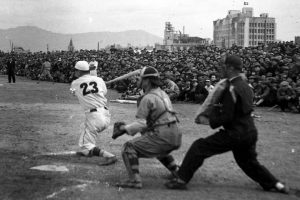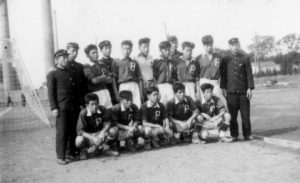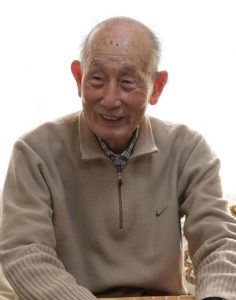Documenting Hiroshima 80 years after A-bombing: In spring of 1948, former military youth makes soccer “memories,” in starting point of soccer stardom
Feb. 3, 2025
by Michio Shimotaka and Maho Yamamoto, Staff Writers
In the spring of 1948, Sachio Shimomura, 16 at the time, who was a second-year student at Shudo High School (in Hiroshima City’s present-day Naka Ward), joined the school’s soccer team. The timing roughly coincided with Mr. Shimomura, now 93, a resident of Fuchu-cho in Hiroshima Prefecture, having lost his aim in life following the end of the war and only being able to imagine a future of “working to go on living.” His interest was piqued by students in grades above him running around on the school ground chasing after a soccer ball, in what was the first step in his soccer career, marked by time serving as the goalkeeper on Japan’s national team.
He had entered Shudo Junior High School under the old education system in 1944. Resolved “to sacrifice his life for the country,” he aimed at attending the Japanese Naval Academy (in present-day Etajima City, Hiroshima Prefecture). On August 6, 1945, he had been mobilized to work on the demolition of buildings and experienced the atomic bombing in the area of Zakoba-cho (in Hiroshima’s present-day Naka Ward), located around one kilometer from the hypocenter. He survived, but he lost his mother, older brother, and grandmother, because the Takajo-machi district (in Hiroshima’s present-day Naka Ward) where they had lived was completely destroyed in the bombing.
Suffered from hunger due to food shortages
Losing his family home, Mr. Shimomura and his father ended up renting a small room of six tatami mats, in which they both lived. They always suffered from hunger due to food shortages in the city. He joined the soccer team “to make good memories,” choosing the goalkeeper position based on the idea that “the keeper would not have to move around as much as the other positions.” The team only had two or three soccer balls. When a ball was damaged, they would stitch it up and use it again. Desks were used in place of goalposts.
A total of 188 students at the former Shudo Junior High School had died in the bombing. Mr. Shimomura said, “Some of my classmates were ‘A-bomb survivors’ like me, and some had been repatriated from overseas territories.” His classmate friends, each facing their own hardships, would come together and cheer on the team at soccer games.
In those days, top-level junior and senior highs schools in Hiroshima competed fiercely at the national level. The junior high school affiliated with Hiroshima Higher Normal School (present-day Hiroshima University Junior and Senior High School) fielded such talented players as Ken Naganuma (who died in 2008 at the age of 77), who later served as a member of Japan’s national soccer team and was a player on the team that won the championship in the fiscal 1947 national junior high-school tournament. In fiscal 1948, Rijo High School (present-day Kokutaiji High School), the renamed former Hiroshima First Middle School, won the national high school tournament. Both schools had lost their buildings in the bombing and had reopened only with great effort.
In the fall of 1949, 11 members of the Shudo High School soccer team set foot on the field of the National Athletic Meet held in Tokyo. Amid the shortage of materials at the time, a relative of the advisor to the soccer team prepared team uniforms by dyeing military surplus shirts dark navy, the team’s color. The team continued to win and, in the semi-final game, it faced Utsunomiya High School (located in Tochigi Prefecture). According to Mr. Shimomura, “The opponent played a system we had never seen in Hiroshima.” His team was narrowly defeated by a score of 2-1, ultimately finishing in third place.
Mr. Shimomura was unhappy about the result, but he also felt a sense of fulfilment not often available to him after the war. He and team members rode a train for nearly one day to visit Tokyo, where he enjoyed making memories of eating natto (fermented soy beans) in the city for the first time in his life. He smiled as he recalled the experience. “It wasn’t very good,” he said. After graduation from high school, he continued to play soccer for Toyo Kogyo (present-day Mazda Motor Corporation). He later became coach of the company team and also served as coach of Japan’s national team.
Place where emotional bonds were established
The soccer field was a place where young people, forced to endure lives of hardship because of the atomic bombing, could connect and establish emotional bonds that transcended their different teams. Bunjiro Yoshida, 90, who lives in Hiroshima’s Naka Ward, was a goalkeeper for the Higashi Senda High School affiliated with Hiroshima University’s Faculty of Education. He experienced an unexpected reunion during a game back at the time.
It was the final game of the 1952 prefectural championship. Mr. Yoshida’s team was playing Shugo High School. At the time of a penalty kick, the opponent standing in front of Mr. Yoshida, the goalkeeper, was a childhood friend with whom he attended Kodo National School. Both players had lost their mothers in the bombing and went their own ways after their school closed. Before the ball was kicked, the young players instinctively drew close and shook hands. Mr. Yoshida narrowed his eyes and said, “Although we were rivals, that moment of reunion on the field was an emotional one.”
(Originally published on February 3, 2025)
In the spring of 1948, Sachio Shimomura, 16 at the time, who was a second-year student at Shudo High School (in Hiroshima City’s present-day Naka Ward), joined the school’s soccer team. The timing roughly coincided with Mr. Shimomura, now 93, a resident of Fuchu-cho in Hiroshima Prefecture, having lost his aim in life following the end of the war and only being able to imagine a future of “working to go on living.” His interest was piqued by students in grades above him running around on the school ground chasing after a soccer ball, in what was the first step in his soccer career, marked by time serving as the goalkeeper on Japan’s national team.
He had entered Shudo Junior High School under the old education system in 1944. Resolved “to sacrifice his life for the country,” he aimed at attending the Japanese Naval Academy (in present-day Etajima City, Hiroshima Prefecture). On August 6, 1945, he had been mobilized to work on the demolition of buildings and experienced the atomic bombing in the area of Zakoba-cho (in Hiroshima’s present-day Naka Ward), located around one kilometer from the hypocenter. He survived, but he lost his mother, older brother, and grandmother, because the Takajo-machi district (in Hiroshima’s present-day Naka Ward) where they had lived was completely destroyed in the bombing.
Suffered from hunger due to food shortages
Losing his family home, Mr. Shimomura and his father ended up renting a small room of six tatami mats, in which they both lived. They always suffered from hunger due to food shortages in the city. He joined the soccer team “to make good memories,” choosing the goalkeeper position based on the idea that “the keeper would not have to move around as much as the other positions.” The team only had two or three soccer balls. When a ball was damaged, they would stitch it up and use it again. Desks were used in place of goalposts.
A total of 188 students at the former Shudo Junior High School had died in the bombing. Mr. Shimomura said, “Some of my classmates were ‘A-bomb survivors’ like me, and some had been repatriated from overseas territories.” His classmate friends, each facing their own hardships, would come together and cheer on the team at soccer games.
In those days, top-level junior and senior highs schools in Hiroshima competed fiercely at the national level. The junior high school affiliated with Hiroshima Higher Normal School (present-day Hiroshima University Junior and Senior High School) fielded such talented players as Ken Naganuma (who died in 2008 at the age of 77), who later served as a member of Japan’s national soccer team and was a player on the team that won the championship in the fiscal 1947 national junior high-school tournament. In fiscal 1948, Rijo High School (present-day Kokutaiji High School), the renamed former Hiroshima First Middle School, won the national high school tournament. Both schools had lost their buildings in the bombing and had reopened only with great effort.
In the fall of 1949, 11 members of the Shudo High School soccer team set foot on the field of the National Athletic Meet held in Tokyo. Amid the shortage of materials at the time, a relative of the advisor to the soccer team prepared team uniforms by dyeing military surplus shirts dark navy, the team’s color. The team continued to win and, in the semi-final game, it faced Utsunomiya High School (located in Tochigi Prefecture). According to Mr. Shimomura, “The opponent played a system we had never seen in Hiroshima.” His team was narrowly defeated by a score of 2-1, ultimately finishing in third place.
Mr. Shimomura was unhappy about the result, but he also felt a sense of fulfilment not often available to him after the war. He and team members rode a train for nearly one day to visit Tokyo, where he enjoyed making memories of eating natto (fermented soy beans) in the city for the first time in his life. He smiled as he recalled the experience. “It wasn’t very good,” he said. After graduation from high school, he continued to play soccer for Toyo Kogyo (present-day Mazda Motor Corporation). He later became coach of the company team and also served as coach of Japan’s national team.
Place where emotional bonds were established
The soccer field was a place where young people, forced to endure lives of hardship because of the atomic bombing, could connect and establish emotional bonds that transcended their different teams. Bunjiro Yoshida, 90, who lives in Hiroshima’s Naka Ward, was a goalkeeper for the Higashi Senda High School affiliated with Hiroshima University’s Faculty of Education. He experienced an unexpected reunion during a game back at the time.
It was the final game of the 1952 prefectural championship. Mr. Yoshida’s team was playing Shugo High School. At the time of a penalty kick, the opponent standing in front of Mr. Yoshida, the goalkeeper, was a childhood friend with whom he attended Kodo National School. Both players had lost their mothers in the bombing and went their own ways after their school closed. Before the ball was kicked, the young players instinctively drew close and shook hands. Mr. Yoshida narrowed his eyes and said, “Although we were rivals, that moment of reunion on the field was an emotional one.”
(Originally published on February 3, 2025)










